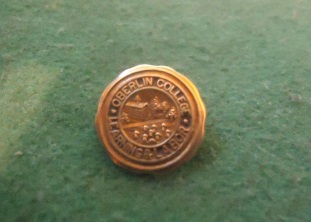Pinned but Not Pinned Down: Laurel and John’s Courtship
John Aird’s memoir describes his first impressions of his
future wife, Laurel Jandy.
“…Laurie was animated, responsive, always ready to laugh,
and interested in almost any subject. Immediately I was interested in her…One
thing troubled me, however. She was wearing a small pin on her sweater which
might very well have been a gift from another man. It could even mean that she
was engaged. I was loath to interpret it that way, but I knew that this was
what such ornaments usually signified. I was careful not to find out.” (page
338)
 |
| Laurel Jandy in 1945 |
College courtship in the 1940s had an extra step between “going
steady” and getting engaged: getting “pinned” or “lavaliered”. Originally this
practice arose in fraternities—the fraternity pin was given to a serious
girlfriend, who would wear it on her sweater or blouse from then on as a visual
symbol, like an engagement ring, of the existence of the relationship. In other
words, the pin was a public symbol that the young lady was “taken”.
A researcher from Southern Illinois University, Jon Gorgosz,
wrote a paper on the practice of
pinning. He quotes a college newspaper article from the early 1950s that noted,
“Pinning is the most serious step so far. It is a step nearer to the engagement
which ultimately leads to marriage. Not only is a frat pin one more symbol of
love and possession, but it also has a deeper and a more lasting feeling
attached to it. To be pinned is not to be taken lightly. It brings the couple
nearer to marriage, a home and a family” (Gothard, 1957). The researcher goes
on to state, “This passage decisively illustrates the connection between
pinning and the movement towards marriage and separates the practice from
“young love” rituals, such as “going steady.”
However, Oberlin College did not have fraternities on campus. What sort of pin was being exchanged there? Did the College itself provide class pins of some sort that male students pressed into service? Were there pins related to the dormitory or house the men lived in? My attempts to find out what sort of pin was used in Laurel’s case have failed. Online searches of Oberlin’s archives have produced no hits thus far. Obviously since John was aware of the symbolic meaning of the pin, the practice was commonly used at Oberlin, despite the lack of records about it.
Perhaps a pin like this Oberlin one?
John discovered later that Laurel’s pin was from a student
or graduate named Ed Ryder who was not on campus that year, and that Laurel
considered herself nearly engaged to Ed. Her friends took her growing
relationship with John badly, making pointed jokes and critical comments. One
remarked that Laurel was at least “white and 21”, referring to the phrase
“free, white and 21” that signaled a woman was available, and implying that
Laurel was not free.
 |
| A courting-appropriate cover on this 1940s Oberlin College bulletin? |
Despite Laurel’s attachment to Ed, and despite the
disapproval of other students, John and Laurel fell in love and married. John
never presented her with a pin—he went straight to an engagement ring and
wedding ring to publicly demonstrate his commitment.
We have Laurel’s letters from her college years. I have only read a few thus far. I hope to find the ones that describe Ed presenting the pin to her, and see how she interpreted the meaning of being pinned. It’s a fascinating window into college courtship in the 1940s.
Sources:
https://opensiuc.lib.siu.edu/cgi/viewcontent.cgi?article=1001&context=esh_2014
Gorgosz, Jon E., "The Practice of Pinning and Its Production of Gendered,
Idealized Images for Women on College Campus in the 1940s, 50s and 60s"
(2014). 2014. Paper 2.http://opensiuc.lib.siu.edu/esh_2014/2
Memoirs of John
Shields Aird, 10 Nov 1919-09 Oct 2005. Pgs. 338-339.





No comments:
Post a Comment